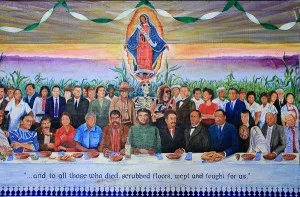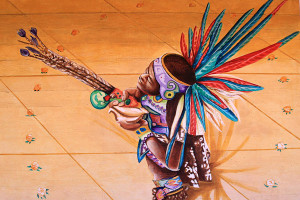Winding up the stairwells, plastering the textured walls outside the dorm and surrounding the diners who choose to sit on the Casa Zapata side of Stern dining hall are a myriad of colorful murals that portray various political movements and issues pertaining to Chicano or Latino identity. From a reinterpretation of Leonardo da Vinci’s “The Last Supper,” in which the title characters are all famous Chicano heroes or social activists, to an image of the immigrant’s journey across the sea and then to a new life, each mural holds a political or social message.
“It’s a generational story,” said Casa Zapata ethnic theme associate Gustavo Gonzalez ’13, of the latter mural. “The grandparents cross the water with their young daughter; they’re looking for a better life. It weaves across generations, and eventually they come to Stanford…It’s the American dream. I think a lot of Latinos can relate to that mural.”
José Antonio Burciaga, an artist who was the Casa Zapata resident fellow (RF) from 1985 to 1994, first conceived of the murals. Those in Stern are only a few of many that sprung up in the 1960s in various regions of California.

“As part of the movement that came out of the civil rights movement, there was this whole artistic component that was all about forging a Mexican-American identity,” said Chris Clarke ’85, current Casa Zapata RF.
Casa Zapata was founded in 1972, during a time when the number of Latino students on campus was growing due to affirmative action. Several of the depictions that embellish the stairwells up to the third floor portray Chicano personalities students may have recognized from their lives prior to Stanford, perhaps allowing students to reconcile their backgrounds with their new lives at an elite university.
“You have the caricatures of the guys who literally are the street ‘vatos’ [‘dudes’],” Clarke said. “The guys who hang out on the corner…these are their friends who they left behind in some ways, right? And they put them on the walls to represent that they have a place here, too.”
The murals have met with some controversy and resistance, however. In particular, the late Ronald Hilton, professor emeritus of Romance languages and founder of Bolívar House and the Institute of Hispanic American and Luso-Brazilian Studies, was especially vocal in his opposition to the politicization of Casa Zapata through the murals. He also disagreed with naming the theme house after Mexican revolutionary Emiliano Zapata, arguing that students were not examining the implications and actions of revolutionaries such as Zapata.

In the mural “The Last Supper of Chicano Heroes,” Ernesto “Che” Guevara is seated in the center, taking the place da Vinci allotted for Jesus Christ in the original painting. An Argentine-born Cuban revolutionary, Guevara is perceived as a hero by some for his role in overthrowing Cuban dictator Fulgencio Batista, and as a murderer by others for numerous executions of Batista supporters. His presence on the mural has led to objections by some community members.
The mural itself, painted by Burciaga, came as a result of a survey of 100 Chicano students at Stanford and 100 Chicano activists. Burciaga asked the participants whom they considered to be the 13 most prominent Chicano heroes.
“I had intended to depict the Last Supper; Christ and his 12 apostles were to be portrayed dining on tortillas, tamales and tequila instead of bread and wine,” Burciaga said in a 1988 Los Angeles Times article. “I dropped that idea when some students expressed dismay at my mixing humor with religion. That’s when I decided to replace the religious figures with 13 Chicano heroes.”
The results ranged from prominent Mexican-American painter Frida Kahlo and comedian Cantínflas to others of non-Mexican descent such as Martin Luther King Jr. and Guevara.
“Latinos are a group-oriented society,” Burciaga continued in his 1988 interview. “Most of Mexico’s national heroes were martyrs, having died in service to the people–from Miguel Hidalgo, father of Mexican independence, who was executed, to revolutionary heroes Francisco Villa and Zapata, who were ambushed and assassinated.”
While pinpointing the “top 13 Chicano heroes” is a contested and highly subjective task, the choices nevertheless reflected the opinions of students at the time.
“Murals are a sort of a reimagining of a community’s values,” said Jeff Chang, associate director of Health & Safety Programs and executive director of the Institute for Diversity in the Arts. “Images become these spaces where people then have big fights over what these values are around the community…But the best thing is that they’re open to multiple interpretations and that encourages the dialogue and the discourse within the community.”
The Casa Zapata murals continue to grow. The lounge mural depicting the immigrant’s journey to the United States is unfinished. Sarita Ocon ’04 returns to campus from time to time to fill in the blank spaces.

Gonzalez reflected on the popular nature of the murals.
“The common people, the poor people, they would see art, and they wanted to see art that would represent everyone,” he said. “And I think these types of murals do that.”
